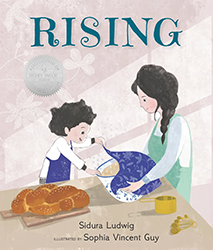Suzanne Wolfe and Jeffrey Ebbeler have taken the old, rhythmic, nursery rhyme, “There Was an Old Lady Who Swallowed a Fly,” and transformed it into a joyful hymn dedicated to Jewish parents. The young rabbi of the title is a religious professional, a mother, and a daughter to aging parents. In this Hanukkah story, the rabbi’s incredible skills at multitasking and her evident fulfillment in all she accomplishes, make her a truly memorable new symbol of the holiday.
When readers first meet the rabbi, she is reading the Torah in her synagogue; a helpful text box clarifies that the Torah is read on Hanukkah, although the story of Hanukkah is not recorded in the Torah. Ebbeler’s illustrations are a wonderful mixture of realism and caricature. The rabbi’s less than perfectly styled hair and oversized glasses, as well as her big smile, make her a familiar image of motherhood, but with enough specific charm to provide individuality. Next she lights the menorah, with her husband and children looking on with loving admiration. Flipping latkes from her frying pan into the air, slamming the oven door shut with her foot as she cooks brisket, and spinning dreidels with her family are all part of her busy holiday observance. Yet the rabbi is not a supermom with stellar abilities which no ordinary parents could hope to imitate; multigenerational cooperation is a big part of her success. Two children assist her in unrolling the Torah scroll and her whole family actively participates in each Hanukkah tradition. A child with a disability is also part of their festive meal. The rabbi opens a gift in a small box from her appreciative husband, who earlier is shown on a snowy night bringing the grandparents, as well as a cake beautifully decorated with a Star of David, to their home. A particularly appealing image shows grandparents watching proudly as the rabbi’s young daughter lights the Hanukkah menorah. One may infer that these are the rabbi’s parents, given the family resemblance between the older and younger woman, which Ebbeler emphasizes humorously by their similar big eyeglasses and warm smiles.
In addition to the information about Torah reading on Hanukkah, Wolfe includes a note about the seven-branched menorah in the Temple era, to accompany Ebbeler’s picture, one of two which brings the book into the past of historic events. Nevertheless, this highly recommended tale is fundamentally a book about family and about the strength of Jewish women, focusing on the rabbi’s melding of her maternal and rabbinic roles. The lilting text and bright pictures create a modern counter-text to the fly-swallowing old lady. Instead of the funny absurdity in that piece of folklore, the young rabbi’s story is one of energetic purpose, as she brings Hanukkah to her family and community.
Emily Schneider writes about literature, feminism, and culture for Tablet, The Forward, The Horn Book, and other publications, and writes about children’s books on her blog. She has a Ph.D. in Romance Languages and Literatures.





